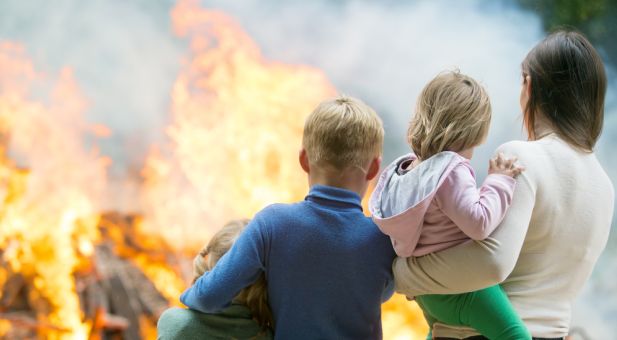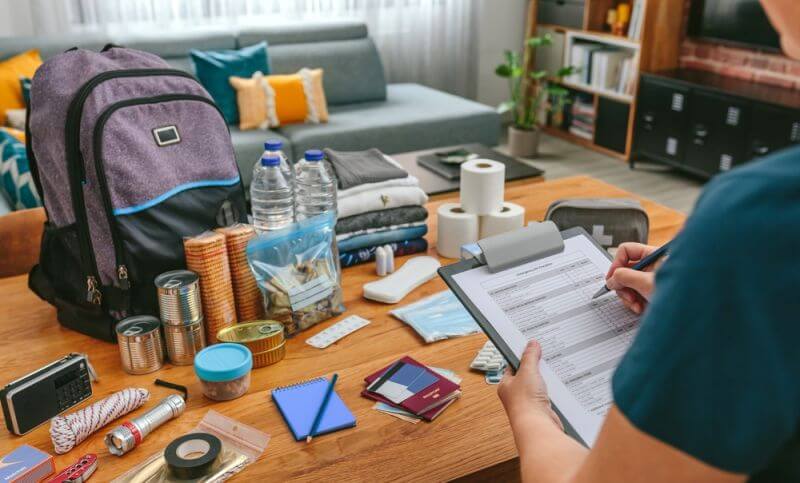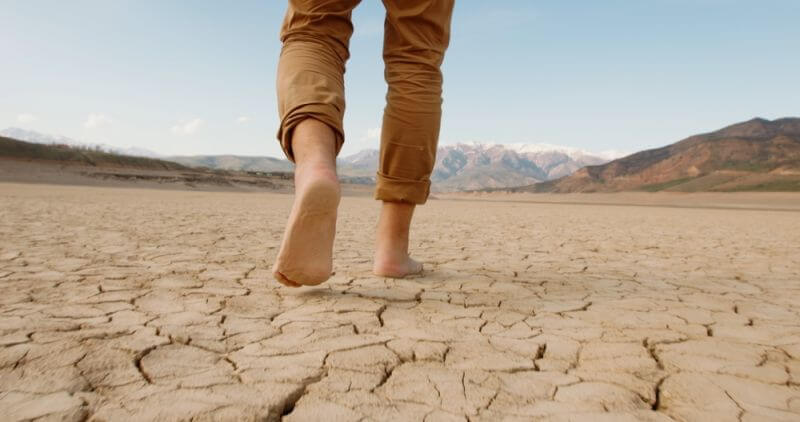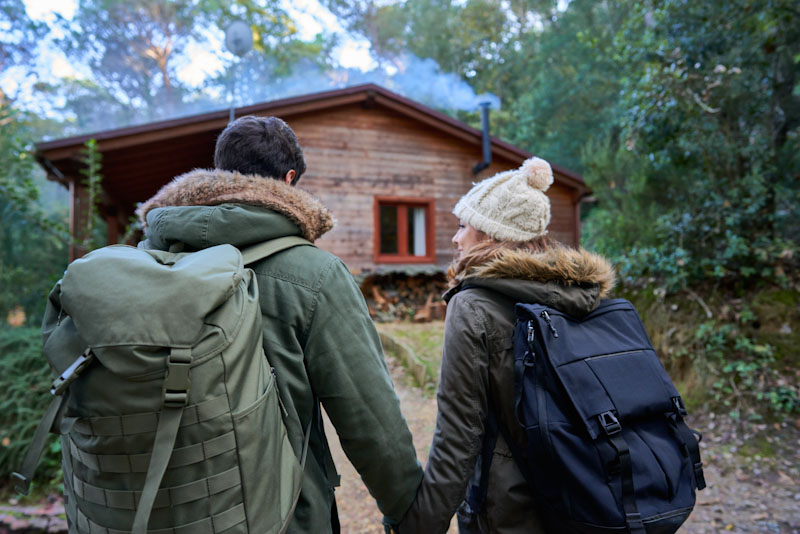The reality of bugging out is something that no prepper can afford to ignore.
Regardless of how well prepared you are and what you’ve done to turn your home into the perfect survival retreat, there are still things that might cause you to have to bug out. Should any of them happen, you want to be ready with your “Plan B” (or perhaps Plan BO).
While we all generally recognize that need, we also tend to make the same mistake in our bug out plan. It’s a rather simple mistake, actually; one that can easily be forgiven. But in the case of a true emergency which would require a bug out, it could end up being a deadly mistake.
That mistake is that we tend to start our bug out plan from an “ideal” condition of having everyone at home and ready to switch into survival mode. While it would be great if things actually worked out that well, chances are rather slim that they will. In our modern society, with family members constantly running in different directions, about the only time you can count on everyone being home, is when everyone is asleep. If you have teens, you might not even be able to count on it then.
This problem can drastically change any bug out, especially if you’re not ready for it. Rather than making grabbing the bug out bags the first step, it makes the first step finding everyone and getting them home. Then you can work on bugging out.
Catch A Glimpse of Green Beret Outdoor Survival Ingenuity
In reality, planning for this part of the bug out can be more complicated than the rest of the bug out. That’s because of the wide variety of variables that can enter into the equation. With each family member having a variety of different places that they go regularly, plus miscellaneous other trips to go shopping and errands during the week, you might actually need several variations on your “get everyone together” plan.
It Starts with Communications
The first part of making this work is having a secure means of getting hold of every family member and making sure they get the bug out signal. With modern cell phones, this is easy, assuming that they are working. But what if they aren’t? What if we’re suddenly hit with an EMP, which not only takes out the grid, but takes out all communications at the same time?
There really isn’t an easy answer for this, at least not one you can be 100% sure of. The best is to decide that in the case of a loss of power and a loss of cell phone communications, everyone puts their get-home-plan into effect. But if you do that, you’re going to have be ready to back your children up, if they leave school and it turns out they are wrong.
Generally speaking, text messages are a more reliable means of communications than voice calls. The bandwidth needed for texting is less than for voice, making it so that text messages will often get through, when there isn’t enough of a signal to make a voice call.
One person in the family should have the responsibility to decide that it’s necessary to bug out. This is usually the person who takes the lead on preparing the family to survive, but it can be another. That’s something for you to decide. Once they send out that first message via text, each family member should call two other family members, to ensure that everyone gets the word. If the system becomes overloaded with other people making the emergency calls, you can’t necessarily count on the first notification getting through.
A very important part of your family’s communications is that you keep each other informed about where you are. This applies to every member of the family, regardless of how much they complain about their individual privacy. That information could be critical in an emergency situation.
Getting the Kids Home
The next challenge is getting the kids home from wherever they are; school or other activities. For the sake of this article, I’m referring to kids who are too young to drive here. Older children, who drive themselves to school or work are treated the same as mom and dad.
Most of the time, younger children will be at school or after-school activities. The good thing about this is that it limits the number of places they are likely to be and most of those places will be near your home. But they may not be close enough to home for your children to get there on their own. So, you need to have a pick-up plan for them.
This pick-up may not be accomplished by the same person who normally picks them up. If mom, for example, normally picks the kids up after school, but her workplace is on the other side of a river, she may have trouble getting there to pick them up. Therefore, whichever driver in the family has the greatest security of being able to pick them up, should be the one assigned this task.
As a backup to that, the kids should be prepared to walk home, assuming that your home is close enough to wherever they are going to be, so that they can do that. As part of that, they should have a pre-planned route to use, which everyone knows, so that it is possible to pick them up along the way.
In addition, the children need some basic gear to help them get home. Most kids carry a backpack to school these days, so it really shouldn’t be a problem to add in a couple of extra things.
How much you add will depend on their level of survival training, how far they have to go to get home and what the school allows them to carry. It is unlikely that the school will be favorable with them carrying a full survival kit, especially the knife and fire-starting part.
Besides, we’re really not trying to prepare them to survive on their own, but to get home on their own. With that in mind, make sure they have:
- Rain poncho
- Tactical flashlight with extra battery
- Laminated map of the area
- Backup battery for their phone
If the children are going to be in a place where they can’t walk home in a couple of hours, especially someplace like on the other side of the river, you may want to add more survival gear and some snacks to that.
Getting Mom & Dad Home
Theoretically, it should be easier to get mom and dad home, as they will be driving. However, chances are they have farther to travel to get home. If something happens to make the roads impassible or render their vehicle unusable, they might have to walk home. Therefore, they should be prepared for that sort of a worst-case scenario.
This means having a full-blown survival kit in the car, which is something we should all do anyway. My EDC (everyday carry) bag is a rather complete survival kit, as well as having things to help me with day-to-day problems. I keep it in the trunk of my car, so that I have it with me, whenever I leave home.
But even that might not be enough. I’d hate to think of some woman trying to walk home 20 miles in high heels in the midst of a disaster. Men’s shoes aren’t so bad for that, but women’s shoes are horrible. So keeping a pair of good walking shoes, like tennis shoes, along with some rugged clothing, a jacket and a hat in the car makes sense as well, if it would be needed.
But don’t stop there; think the situation through all the way. I’ve mentioned the phrase, “across the river” a couple of times. What if you have a family member who works on the other side of the river and the bridge is down? How will they get home then? Is that likely?
That depends on the chances of earthquakes in the area where you live. I know that if I lived in southern California and worked on the other side of the river, I’d at least keep an inner tube and a pump in the trunk of my car, if not a small inflatable rubber boat.
Keep in mind that you’re prepping for what can happen; not just for what you think is likely to happen. Limiting yourself to just those things which you think are likely could end up being very dangerous. Better to over-prepare and not need it, than to need it and not have prepared for it. An inner tube isn’t all that expensive and doesn’t take up that much room in the trunk of your car
A Backup Meeting Place
One more thing you need is a backup meeting place. Since a bug out plan is a contingency plan anyway, we need to consider all our contingencies. That includes the possibility of not being able to meet at home, in the case that something has made the house uninhabitable, such as a flood, earthquake or radiation.
In such a case, you need a backup place for your family to meet; preferably someplace that wouldn’t be affected by the types of things that could make your home uninhabitable; perhaps someplace on higher ground. At the same time, it needs to be close enough to home, that family members can make it there on foot.
As part of your plan, whoever has made it home should leave to go to this alternate meeting place after X number of hours or days, taking all your bug out equipment with them. They should then remain in that place until the rest of the family arrives or it is clear that they won’t arrive. From there, you can execute your bug out plan.
Of course, if everyone in the family knows the bug out plan, than anyone who doesn’t make it home or to this secondary meeting place would still have the ability to continue on and meet up with the family later, either en route or at your survival retreat.










TruthB Told | August 21, 2018
|
“Don’r forget your pets”. Really? 1..What kind of pet? 2. Is the “pet” a rottweiler or a toy poodle ? 3. If it is a “defensive” pet , is it trained to keep quite and to attack on command? 4. How are you going to “feed” your pet? A “pet rock” is the perfect “bugout” pet. You don’t have to feed it. It stays quiet. And you can use it as a weapon for defense.
Bill in Idaho | August 21, 2018
|
Bill, You have hit Solidly on the basics – the Essentials. Thank You. I know that you have Much More to share with us – Please do ! Take Care and GOD Bless !
Raymond A Finney | August 21, 2018
|
Please explain in a future column why it is safer/ more desirable to “bug out,” rather than sheltering in place in my home. After “bugging out,” I am mostly defenseless, have limited supplies, and am surrounded by hostile and unfamiliar surroundings teeming with looters. Staying in place in my home, I have multiple weapons and tools, have a large cache of food and other supplies, am protected by solid doors, etc. I simply cannot understand the “wisdom,” if such exists, of retreating to the woods somewhere and hunkering down in a tent. Please correct my thinking, if you can.
William Halford | August 21, 2018
|
Although I would agree that staying at home is best in some situations, it really depends. One situation where I would be better off leaving home is in case of a serious flood. I’d have some time to get out of the area before my house floods, although being just outside of the 100 and 500 year floodplains, it’s unlikely unless the dam that’s 40 miles away breaks.
Another factors is where you can go to bug out. Not everyone lives in a highly populated place where there would be a lot of people out where you are bugging out to. Living where I do, I have plenty of desert places to choose from, and not all that far away. I know of places where there’s water in the desert, and also places near that water where I can stay hidden.
As far as unfamiliar surroundings go, that’s why you get out there and find places you can bug out to, and find several to choose from.
James F M Baur Jr | August 21, 2018
|
Sometimes it’s smarter to fade away for awhile until the chaos settles down. If you have the essentials, particularly enough food and water, and are aware of a safe spot from previous recon, you, and your family may be safer out in the woods for a (hopefully) short period of time. Remember that hungry people will be searching the woods, too, for prey, both human and nonhuman) in order to survive, as well. Their mindset, in the woods, is simpler than it would be in the city: No witness, no crime. Their chances of being caught are seriously reduced in this scenario.
Your absolute best chances lie with trusted family, and friends who have outdoor knowledge, and the appropriate survival skill sets. Then you MAY/MIGHT survive. Involve as few people in your plans as possible, but remember that even they
won’t always be as trustworthy as you might believe them to be. Always have your own back, or pay the price.
Paranoia is its own sickness. Try to avoid it,
while preparing for the End Of The World As You Know It scenario you envision. Start building your “group” today.
I suggest friends who have been in the military, either with you, or not, as they tend to understand the limited range of
options available in these types of situations, while providing viable suggestions, and possible solutions to many problems.
Been to church lately? That may be a good place to start looking for
like minded individuals with a military, or survival, background.
These types of circumstances require a different perspective than the one you currently hold. That’s because you are reasonably safe right now. Try to remain open, flexible, and optimistic, given the new realities confronting you immediately should, God forbid, you find yourself in one of the many life, or death, scenarios which WILL occur on a regular basis once society breaks down.
By the way, I have breached many, many doors in combat situations. Unless yours are steel, I’ll be in your face within
10-15sec. Steel will take about 20sec. Sleep well, and pray that your Twilight Zone episode never happens for real.
The 'Dang Duffy's | August 21, 2018
|
After about 3 days those that are not prepared will be running out of food and water, and wondering where their family members are. There will be fear about what will happen next. Bugging in your home is great, until the hungry and sick start showing up for hand outs. You should always have a secondary bug out location, near if possible, maybe with a like minded family member or neighbor. If you hunker down for a few days and notice things are not improving, than it’s time to go…..remember if you want to go fast go alone. If you want to go far go together. There is safety in numbers and sometimes it is better to stay put, sometimes it is not. It is entirely up to you. My husband and I will be bugging out to the woods if necessary, we are prepared to do that. But we would prefer to stay in our home and we will until it’s time to go.
Clergylady | August 22, 2018
|
I live an hours drive from a city. Bugging in is defiantly first choice but a wild fire or a few more unlikely circumstances could make bugging out necessary. Bags are ready to grab and a case of water could be grabbed in a hurry. Chickens, ducks, and rabbits can’t go along unless I take a favorite pair to start over with again later..
Husband has Alzheimer’s so he’s with me at all times. Neighbors raising grand kids might head out together if everyone is home.
DarrenR | September 21, 2018
|
good article with good ideas. though you left a gaping hole in “Getting the kids home’ part: their school(s).
the saying is that “those who can, do; those who can not, teach”. add to that “and the true ‘tards end up in administration”. what this means is that if a Situation presents itself, it’s entirely possible that some wing nuts are going to try to prevent your kids from leaving on their own.
it’s not like teachers, administrators, superintendents, and police will simply say “yes, go ahead and leave”. not going to happen. whether they force your kids to “shelter in place” or take them to a “safer, undisclosed location” almost doesn’t matter. either way, your kids will likely be denied access to their locker (belongings, jacket, get home bag), the bike rack, and the exit door/gate. so to your article, i will add:
consider each of your childrens’ individual scenario: maturity levels, dietary needs, prescription medicines, siblings, your rapport/comfort levels with individual school personnel as well as the entire administration.
teach your kids to scope out any exits, emergency exits, and hiding places at the school. (to find hiding places, ask the stoners).
make sure your kids’ clothing is appropriately sized, comfortable, and suited to extreme temperature range. too small constrains them when they need to run. too large makes them easy-to-grab by cop or school personnel. clothing is a sensitive subject for most kids, but they’ll come around fast if you explain this is so they can easily ESCAPE from school.
make sure they ditch their school id card in an escape-school emergency. RFID chips in school ids are used to track the physical whereabouts of your child: unless the id gets left with a friend, shoved into a library book, or thrown over a ceiling tile next to the dead squirrel from last fall.
figure out at least three different ways for your kids to get home from school that involve no major roads, landmarks, or gathering places. walk each of these routes at least once with your child. this helps gauge the practicality of the route, as well as helps your child to remember it.
scope out a few places your kids can shelter (hide) in on the way home such as a convenience store. talk to store managers/owners along those routes as to make any pre-arrangements.
give your child ten dollars in singles to be kept in a separate place from their regular day to day money. randomly test your kids to make sure they can pull those “for emergency only” singles out of their socks so you know they have not spent it on non-emergencies.
the emergency singles enable your kids to pay for ride on city bus, or to buy a hot dog/slurpee at the convenience store they are sheltering at. pre-arranged or not, this gives your kids a ‘right’ to wait inside the convenience store until it’s safe to continue home, or await your arrival to pick them up.
just as public schools are really government schools, the city buses are government buses. make sure your kids know that jumping on the bus could mean they are jumping on the BUST.
teach your kids to hide themselves in the back of the store if they need to wait or shelter there. staring out the big plate glass window up front is exactly where they should not be.
escaping thru windows at school is likely impractical. even those on the first floor are pretty high up off the ground.
keeping a get-home-from-school bag in the bottom of their locker is a good idea. however make sure your kid knows to leave that in their locker, and their bike behind at the rack if trying to get such increases their risk of being detained. if time is short, and access to these items is a likely bust, your kids should simply leave the school with the clothes on their back. fact is: sometimes you just have to leave everything behind.
teach your kids to behave themselves in the general community. this lessens the likelihood of their being denied help in a genuine emergency.
raise your kids in a healthy lifestyle. sprinting a mile or few to evade personnel/police is much easier if they have proper diet and are in decent condition to run to begin with.
consider homeschooling. not only will your kids be far smarter and more skilled as a result, but you won’t have to deal with any of the above in an emergency.